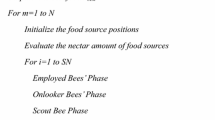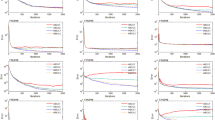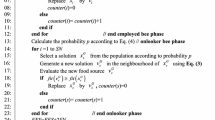Abstract
Artificial bee colony (ABC) is a recent swarm intelligence algorithm. There have been some greedy ABC variants developed to enhance the exploitation capability, but greedy variants are usually less reliable and may cause premature convergence, especially without proper control on the greediness degree. In this paper, we propose an adaptive ABC algorithm (AABC), which is characterized by a novel greedy position update strategy and an adaptive control scheme for adjusting the greediness degree. The greedy position update strategy incorporates the information of top t solutions into the search process of the onlooker bees. Such a greedy strategy is beneficial to fast convergence performance. In order to adapt the greediness degree to fit for different optimization scenarios, the proposed adaptive control scheme further adjusts the size of top solutions for selection in each iteration of the algorithm. The adjustment is based on considering the current search tendency of the bees. This way, by combining the greedy position update process and the adaptive control scheme, the convergence performance and the robustness of the algorithm can be improved at the same time. A set of benchmark functions is used to test the proposed AABC algorithm. Experimental results show that the components of AABC can significantly improve the performance of the classic ABC algorithm. Moreover, the AABC performs better than, or at least comparably to, some existing ABC variants as well as other state-of-the-art evolutionary algorithms.





Similar content being viewed by others
References
Akay B, Karaboga D (2009) Parameter tuning for the artificial bee colony algorithm. In: Nguyen NT, Kowalczyk R, Chen SM (eds) Computational collective intelligence. Semantic web, social networks and multiagent systems. Springer, Berlin, pp 608–619
Akay B, Karaboga D (2012) A modified artificial bee colony algorithm for real-parameter optimization. Inf Sci 192:120–142
Alzaqebah M, Abdullah S (2011) Artificial bee colony search algorithm for examination timetabling problems. Int J Phys Sci 6(17):4264–4272
Auger A, Hansen N (2005) Performance evaluation of an advanced local search evolutionary algorithm. In: The 2005 IEEE congress on evolutionary computation, 2005, vol 2, pp 1777–1784
Banharnsakun A, Achalakul T, Sirinaovakul B (2010) ABC-GSX: a hybrid method for solving the traveling salesman problem. In: 2010 second world congress on nature and biologically inspired computing, pp 7–12
Banharnsakun A, Achalakul T, Sirinaovakul B (2011) The best-so-far selection in artificial bee colony algorithm. Appl Soft Comput 11(2):2888–2901
Bao L, Zeng JC (2009) Comparison and analysis of the selection mechanism in the artificial bee colony algorithm. In: 2009 ninth international conference on hybrid intelligent systems, vol 1, pp 411–416
Bharti KK, Singh PK (2015) Chaotic gradient artificial bee colony for text clustering. Soft Comput 20(3):1–14
Bonabeau E, Dorigo M, Theraulaz G (1999) Swarm intelligence: from natural to artificial systems. Oxford University Press, Oxford
Cuevas E, Sención-Echauri F, Zaldivar D, Pérez-Cisneros M (2012) Multi-circle detection on images using artificial bee colony (ABC) optimization. Soft Comput 16(2):281–296
Deb K, Anand A, Joshi D (2002) A computationally efficient evolutionary algorithm for real-parameter optimization. Evol Comput 10(4):371–395
Derrac J, García S, Molina D, Herrera F (2011) A practical tutorial on the use of nonparametric statistical tests as a methodology for comparing evolutionary and swarm intelligence algorithms. Swarm Evol Comput 1(1):3–18
Diwold K, Aderhold A, Scheidler A, Middendorf M (2011) Performance evaluation of artificial bee colony optimization and new selection schemes. Memet Comput 3(3):149–162
Dorigo M, Maniezzo V, Colorni A (1996) Ant system: optimization by a colony of cooperating agents. IEEE Trans Syst Man Cybern Part B Cybern 26(1):29–41
Gao WF, Liu SY (2012) A modified artificial bee colony algorithm. Comput Oper Res 39(3):687–697
Gao WF, Liu SY, Huang LL (2013) A novel artificial bee colony algorithm based on modified search equation and orthogonal learning. IEEE Trans Cybern 43(3):1011–1024
Gu B, Sheng VS, Tay KY, Romano W, Li S (2015a) Incremental support vector learning for ordinal regression. IEEE Trans Neural Netw Learn Syst 26(7):1403–1416
Gu B, Sheng VS, Wang Z, Ho D, Osman S, Li S (2015b) Incremental learning for \(\nu \)-support vector regression. Neural Netw 67:140–150
Hansen N, Ostermeier A (2001) Completely derandomized self-adaptation in evolution strategies. Evol Comput 9(2):159–195
Hsieh TJ, Yeh WC (2011) Knowledge discovery employing grid scheme least squares support vector machines based on orthogonal design bee colony algorithm. IEEE Trans Syst Man Cybern Part B Cybern 41(5):1198–1212
Karaboga D (2005) An idea based on honey bee swarm for numerical optimization. Technical report, Technical report-tr06, Erciyes University, Engineering Faculty, Computer Engineering Department
Karaboga D, Akay B (2009) A comparative study of artificial bee colony algorithm. Appl Math Comput 214(1):108–132
Karaboga D, Basturk B (2007) A powerful and efficient algorithm for numerical function optimization: artificial bee colony (ABC) algorithm. J Glob Optim 39(3):459–471
Karaboga D, Basturk B (2008) On the performance of artificial bee colony (ABC) algorithm. Appl Soft Comput 8(1):687–697
Kenndy J, Eberhart R (1995) Particle swarm optimization. Proc IEEE Int Conf Neural Netw 4:1942–1948
Liang JJ, Qin AK, Suganthan PN, Baskar S (2006) Comprehensive learning particle swarm optimizer for global optimization of multimodal functions. IEEE Trans Evol Comput 10(3):281–295
Pan QK, Tasgetiren MF, Suganthan PN, Chua TJ (2011) A discrete artificial bee colony algorithm for the lot-streaming flow shop scheduling problem. Inf Sci 181(12):2455–2468
Pan QK, Wang L, Mao K, Zhao JH, Zhang M (2013) An effective artificial bee colony algorithm for a real-world hybrid flowshop problem in steelmaking process. IEEE Trans Autom Sci Eng 10(2):307–322
Pan Z, Zhang Y, Kwong S (2015) Efficient motion and disparity estimation optimization for low complexity multiview video coding. IEEE Trans Broadcast 61(2):166–176
Pham DT, Castellani M (2014) Benchmarking and comparison of nature-inspired population-based continuous optimisation algorithms. Soft Comput 18(5):871–903
Shang YW, Qiu YH (2006) A note on the extended Rosenbrock function. Evol Comput 14(1):119–126
Suganthan PN, Hansen N, Liang JJ, Deb K, Chen YP, Auger A, Tiwari S (2005) Problem definitions and evaluation criteria for the CEC 2005 special session on real-parameter optimization. Technical report, KanGAL report
Tinghuai M, Jinjuan Z, Meili T, Yuan T, Abdullah AD, Mznah AR, Sungyoung L (2015) Social network and tag sources based augmenting collaborative recommender system. IEICE Trans Inf Syst 98(4):902–910
Tsai P, Pan J, Liao B, Chu S (2008) Interactive artificial bee colony (IABC) optimization. In: Proceedings of ISI2008 (Taiwan)
Wang Y, Cai Z, Zhang Q (2011) Differential evolution with composite trial vector generation strategies and control parameters. IEEE Trans Evol Comput 15(1):55–66
Wen X, Shao L, Xue Y, Fang W (2015) A rapid learning algorithm for vehicle classification. Inf Sci 295:395–406
Xia Z, Wang X, Sun X, Wang B (2014) Steganalysis of least significant bit matching using multi-order differences. Secur Commun Netw 7(8):1283–1291
Yao X, Liu Y, Lin G (1999) Evolutionary programming made faster. IEEE Trans Evol Comput 3(2):82–102
Yu WJ, Zhang J, Chen WN (2013) Adaptive artificial bee colony optimization. In: Proceedings of the 15th annual conference on genetic and evolutionary computation, pp 153–158
Yu WJ, Shen M, Chen WN, Zhan ZH, Gong YJ, Lin Y, Liu O, Zhang J (2014) Differential evolution with two-level parameter adaptation. IEEE Trans Cybern 44(7):1080–1099
Zhan ZH, Zhang J, Li Y, Chung HSH (2009) Adaptive particle swarm optimization. IEEE Trans Syst Man Cybern Part B Cybern 39(6):1362–1381
Zhang J, Chung HSH, Lo WL (2007) Clustering-based adaptive crossover and mutation probabilities for genetic algorithms. IEEE Trans Evol Comput 11(3):326–335
Zhou X, Wang H, Wang M, Wan J (2015) Enhancing the modified artificial bee colony algorithm with neighborhood search. Soft Comput. doi:10.1007/s00500-015-1977-x
Zhu G, Kwong S (2010) Gbest-guided artificial bee colony algorithm for numerical function optimization. Appl Math Comput 217(7):3166–3173
Acknowledgments
This work was supported by the National Natural Science Foundation of China (Grant Nos. 61502544, 61402545, and 61332002).
Author information
Authors and Affiliations
Corresponding author
Ethics declarations
Conflict of interest
Wei-Jie Yu, Zhi-Hui Zhan, and Jun Zhang declare that they have no conflict of interest.
Ethical approval
This article does not contain any studies with human participants or animals performed by any of the authors.
Additional information
Communicated by V. Loia.
Rights and permissions
About this article
Cite this article
Yu, WJ., Zhan, ZH. & Zhang, J. Artificial bee colony algorithm with an adaptive greedy position update strategy. Soft Comput 22, 437–451 (2018). https://doi.org/10.1007/s00500-016-2334-4
Published:
Issue Date:
DOI: https://doi.org/10.1007/s00500-016-2334-4




